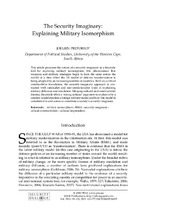| dc.contributor.author | Pretorius, Joelien | |
| dc.date.accessioned | 2021-02-02T07:30:19Z | |
| dc.date.available | 2021-02-02T07:30:19Z | |
| dc.date.issued | 2008 | |
| dc.identifier.citation | Pretorius, J. (2008). The security imaginary: Explaining military isomorphism. Security Dialogue ,39(1) ,99-120 | en_US |
| dc.identifier.uri | https://www.jstor.org/stable/26299665 | |
| dc.identifier.uri | http://hdl.handle.net/10566/5808 | |
| dc.description.abstract | This article proposes the notion of a security imaginary as a heuristic tool for exploring military isomorphism (the phenomenon that weapons and military strategies begin to look the same across the world) at a time when the US model of defence transformation is being adopted by an increasing number of countries. Built on a critical constructivist foundation, the security-imaginary approach is contrasted with rationalist and neo-institutionalist ways of explaining military diffusion and emulation. Merging cultural and constructivist themes, the article offers a 'strong cultural' argument to explain why a country would emulate a foreign military model and how this model is constituted in and comes to constitute a society's security imaginary. | en_US |
| dc.language.iso | en | en_US |
| dc.publisher | SAGE | en_US |
| dc.subject | Military isomorphism | en_US |
| dc.subject | RMA | en_US |
| dc.subject | Security imaginary | en_US |
| dc.subject | Critical constructivism | en_US |
| dc.subject | Cultural imperialism | en_US |
| dc.title | The security imaginary: Explaining military isomorphism | en_US |
| dc.type | Article | en_US |

